Submitted:
24 November 2023
Posted:
28 November 2023
You are already at the latest version
Abstract
Keywords:
1. Introduction
1.1. Research Background
1.2. EEG Technology
1.2.1. Four Functional Areas of the Brain
1.2.2. Five Brain Wave Frequencies
1.2.3. The International 10-20 Electrode Placement System
1.2.4. Portable EEG Monitoring Devices
Traditional Scalp EEG
Ear-EEG
1.3. EEG Monitoring of Worker Adverse Reactions and Construction Hazard Identification
1.4. Contributions of the Review
2. Review Methodology
2.1. Literature Research
2.2. Selection Criteria
- Consider combining EEG monitoring with subjective monitoring during the monitoring process.
- In terms of monitoring adverse reactions in construction workers through EEG, consider mood monitoring, fatigue monitoring, distraction monitoring, and vigilance monitoring of workers.
- Aspects of the identification of hazardous behavior in construction through EEG include monitoring at the construction site and simulation of the construction site environment in the laboratory through VR technology.
3. Worker’s Adverse Reaction Monitoring and Construction Hazard Identification
3.1. Workers Adverse Effects
3.1.1. Emotional Aspect of Workers
3.1.2. Work Fatigue Monitoring
3.1.3. Distraction and Psychological Burden of Workers
3.1.4. Vigilance Aspect of Workers
3.2. Construction Hazard Identification
4. Discussion and Limitations
Conclusions and Future Perspectives
Author Contributions
Funding
Institutional Review Board Statement
Informed Consent Statement
Data Availability Statement
Acknowledgments
Conflicts of Interest
Abbreviations
| EEG Electroencephalogram MEG Magnetoencephalography EMG Electromyogram ECG Electrocardiogram EOG Electro-oculogram EDA Electrodermal Activity TCV Thermal Comfort Vote TSV Thermal Sensation Vote SVF Sky View Factor BCI Brain-Machine Interface ERP Event-related Potential SVM Support Vector Machines IVE Immersive Virtual Environment WPT Wavelet Packet Transform CSA Center Sleep Apnea MSA Mix Sleep Apnea PMR Progressive Muscle Relaxation TNS Trigeminal Nerve Stimulation |
NALA-TLX NASA Task Load Index ML Machine Learning DL Deep Learning CNN Convolutional Neural Networks MMN Mismatch Negativity HMD Head-mounted Device RBD REM Sleep Behavior Disorder OSA Obstructive Sleep Apnea PSG Polysomnography TSV Thermal Sensation Vote MTSV Mean TSV TCV Thermal Comfort Vote PSD Power Spectral Density VAD Valence-Arousal-Dominance α Alpha β Beta θ Theta δ Delta γ Gamma |
References
- Birhane G E, Yang L, Geng J, et al. Causes of construction injuries: a review[J]. International journal of occupational safety and ergonomics, 2022, 28(1): 343-353. [CrossRef]
- Hinze J W, Teizer J. Visibility-related fatalities related to construction equipment[J]. Safety science, 2011, 49(5): 709-718. [CrossRef]
- Xing X, Zhong B, Luo H, et al. Effects of physical fatigue on the induction of mental fatigue of construction workers: A pilot study based on a neurophysiological approach[J]. Automation in Construction, 2020, 120: 103381. [CrossRef]
- Fang D, Wang Y, Lim H W, et al. Construction of a Bayesian network based on leadership-culture-behavior model to improve owner safety management behavior[J]. Journal of Construction Engineering and Management, 2023, 149(3): 04022177. [CrossRef]
- Fang D, Zhao C, Zhang M. A cognitive model of construction workers’ unsafe behaviors[J]. Journal of Construction Engineering and Management, 2016, 142(9): 04016039. [CrossRef]
- Aryal A, Ghahramani A, Becerik-Gerber B. Monitoring fatigue in construction workers using physiological measurements[J]. Automation in Construction, 2017, 82: 154-165. [CrossRef]
- Marcora S M, Staiano W, Manning V. Mental fatigue impairs physical performance in humans[J]. Journal of applied physiology, 2009. [CrossRef]
- Tempesta D, Socci V, De Gennaro L, et al. Sleep and emotional processing[J]. Sleep medicine reviews, 2018, 40: 183-195. [CrossRef]
- Li H, Wang D, Chen J, et al. Pre-service fatigue screening for construction workers through wearable EEG-based signal spectral analysis[J]. Automation in Construction, 2019, 106: 102851. [CrossRef]
- Abdelhamid T S, Everett J G. Physiological demands during construction work[J]. Journal of construction engineering and management, 2002, 128(5): 427-437. [CrossRef]
- Haslam R A, Hide S A, Gibb A G F, et al. Contributing factors in construction accidents[J]. Applied ergonomics, 2005, 36(4): 401-415. [CrossRef]
- Zhang M, Murphy L A, Fang D, et al. Influence of fatigue on construction workers’ physical and cognitive function[J]. Occupational Medicine, 2015, 65(3): 245-250. [CrossRef]
- Zhang L, Wang J, Wang Y, et al. Automatic construction site hazard identification integrating construction scene graphs with BERT based domain knowledge[J]. Automation in Construction, 2022, 142: 104535. [CrossRef]
- P. Ricciardi, C. Buratti, Environmental quality of university classrooms: Subjective and objective evaluation of the thermal, acoustic, and lighting comfort conditions, Build. Environ. 127 (2018) 23–36. [CrossRef]
- R. de Dear, Thermal comfort in practice, Indoor Air. 14 (2004) 32–39. [CrossRef]
- C.E. Ochoa, I.G. Capeluto, Evaluating visual comfort and performance of three natural lighting systems for deep office buildings in highly luminous climates, Build. Environ. 41 (2006) 1128–1135. [CrossRef]
- C. Buratti, E. Belloni, F. Merli, P. Ricciardi, A new index combining thermal, acoustic, and visual comfort of moderate environments in temperate climates, Build. Environ. 139 (2018) 27–37. [CrossRef]
- N. Perrin Jegen, P. Chevret, Effect of noise on comfort in open-plan offices: application of an assessment questionnaire, Ergonomics. 60 (2017) 6–17. [CrossRef]
- M. Pierrette, E. Parizet, P. Chevret, J. Chatillon, Noise effect on comfort in open-space offices: development of an assessment questionnaire, Ergonomics. 58 (2015) 96–106. [CrossRef]
- P. Wargocki, D.P. Wyon, Y.K. Baik, G. Clausen, P.O. Fanger, Perceived air quality, sick building syndrome (SBS) symptoms and productivity in an office with two different pollution loads, Indoor Air-Int. J. Indoor Air Qual. Clim. 9 (1999) 165–179. [CrossRef]
- L. Lan, P. Wargocki, D.P. Wyon, Z. Lian, Effects of thermal discomfort in an office on perceived air quality, SBS symptoms, physiological responses, and human performance, Indoor Air-Int. J. Indoor Air Qual. Clim. 21 (2011) 376–390. [CrossRef]
- Carvajal-Arango D, Vasquez-Hernandez A, Botero-Botero L F. Assessment of subjective workplace well-being of construction workers: A bottom-up approach[J]. Journal of Building Engineering, 2021, 36: 102154. [CrossRef]
- Rozenfeld, R. Sacks, Y. Rosenfeld, H. Baum, Construction job safety analysis, Saf. Sci. 48 (2010) 491–498. [CrossRef]
- H.-H. Wang, F. Boukamp, Ontology-based representation and reasoning framework for supporting job hazard analysis, J. Comput. Civ. Eng. 25 (2011) 442–456. [CrossRef]
- Pinto A, Nunes I L, Ribeiro R A. Occupational risk assessment in construction industry–Overview and reflection[J]. Safety science, 2011, 49(5): 616-624. [CrossRef]
- Pan.Y,Wan.Y,Chen.G,Research on Neural Information Systems: Current Status and Prospects[J]. JOURNAL OF MANAGEMENT SCIENCES IN CHINA,2018,21(05):1-21.
- Szafir, D.; Signorile, R. An exploration of the utilization of electroencephalography and neural nets to control robots. In Proceedings of the IFIP Conference on Human-Computer Interaction, Lisbon, Portugal, 5–9 September 2011; pp. 186–194. [Google Scholar] [CrossRef]
- Inagaki H K, Chen S, Ridder M C, et al. A midbrain-thalamus-cortex circuit reorganizes cortical dynamics to initiate planned movement[J]. bioRxiv, 2020: 2020.12. 16.423127. [CrossRef]
- Wu M, Li H, Qi H. Using electroencephalogram to continuously discriminate feelings of personal thermal comfort between uncomfortably hot and comfortable environments[J]. Indoor Air, 2020, 30(3): 534-543. [CrossRef]
- Lu M, Hu S, Mao Z, et al. Research on work efficiency and light comfort based on EEG evaluation method[J]. Building and Environment, 2020, 183: 107122. [CrossRef]
- Lang X, Wang Z, Tian X, et al. The effects of extreme high indoor temperature on EEG during a low intensity activity[J]. Building and Environment, 2022, 219:109225. [CrossRef]
- Zhang L, Fabbri D, Upender R, et al. Automated sleep stage scoring of the Sleep Heart Health Study using deep neural networks[J]. Sleep, 2019, 42(11): zsz159. [CrossRef]
- Boostani R, Karimzadeh F, Nami M. A comparative review on sleep stage classification methods in patients and healthy individuals[J]. Computer methods and programs in biomedicine, 2017, 140: 77-91. [CrossRef]
- Ishman S L, Yang C J, Cohen A P, et al. Is the OSA-18 predictive of obstructive sleep apnea: comparison to polysomnography[J]. The Laryngoscope, 2015, 125(6): 1491-1495. [CrossRef]
- Colín-Cano C, Ruiz-Morales M, Ledo-Gutiérrez L, et al. Correlation between the clinical inventory of sleep quality (CISQ) and polisomnographic (PSG) characteristics in patients with obstructive sleep apnea syndrome (OSA)[J]. Sleep Medicine, 2017, 40: e150. [CrossRef]
- Kritzinger F E, Al-Saleh S, Narang I. Descriptive analysis of central sleep apnea in childhood at a single center[J]. Pediatric pulmonology, 2011, 46(10): 1023-1030. [CrossRef]
- Neikrug A B, Ancoli-Israel S. Diagnostic tools for REM sleep behavior disorder[J]. Sleep medicine reviews, 2012, 16(5): 415-429. [CrossRef]
- Tabar Y R, Mikkelsen K B, Rank M L, et al. Ear-EEG for sleep assessment: a comparison with actigraphy and PSG[J]. Sleep and Breathing, 2021, 25: 1693-1705. [CrossRef]
- Scanlon J E M, Jacobsen N S J, Maack M C, et al. Outdoor walking: Mobile EEG dataset from walking during oddball task and walking synchronization task[J]. Data in Brief, 2023, 46: 108847. [CrossRef]
- Jacobsen N S J, Blum S, Witt K, et al. A walk in the park? Characterizing gait-related artifacts in mobile EEG recordings[J]. European Journal of Neuroscience, 2021, 54(12): 8421-8440. [CrossRef]
- Tang S, Wang J, Liu W, et al. A study of the cognitive process of pedestrian avoidance behavior based on synchronous EEG and eye movement detection[J]. Heliyon, 2023, 9(3). [CrossRef]
- Ma X, Song L, Hong B, et al. Relationships between EEG and thermal comfort of elderly adults in outdoor open spaces[J]. Building and Environment, 2023, 235: 110212. [CrossRef]
- J.N. Demos, Getting Started with Neurofeedback, WW Norton & Company, New York, 2005. ISBN: 0-393-07553-2.
- M.X. Cohen, Analyzing Neural Time Series Data: Theory and Practice, MIT press, Cambrige, 2014. ISBN: 0-262-31956-X.
- Sharbrough, F.; Chatrian, G.E.; Lesser, R.P.; Luders, H.; Nuwer, M.; Picton, T.W. American electroencephalographic society guidelines for standard electrode position nomenclature. J. Clin. Neurophysiol. 1991, 8, 200–202. [Google Scholar]
- Xu Q, Chong H Y, Liao P. Exploring eye-tracking searching strategies for construction hazard recognition in a laboratory scene[J]. Safety Science, 2019, 120: 824-832. [CrossRef]
- Patel S, Park H, Bonato P, et al. A review of wearable sensors and systems with application in rehabilitation[J]. Journal of neuroengineering and rehabilitation, 2012, 9(1): 1-17. [CrossRef]
- Nnaji C, Okpala I, Awolusi I. Wearable sensing devices: Potential impact & current use for incident prevention[J]. Professional safety, 2020, 65(04): 16-24. [CrossRef]
- Abuwarda Z, Mostafa K, Oetomo A, et al. Wearable devices: Cross benefits from healthcare to construction[J]. Automation in Construction, 2022, 142: 104501. [CrossRef]
- Wang Y, Huang Y, Gu B, et al. Identifying mental fatigue of construction workers using EEG and deep learning[J]. Automation in Construction, 2023, 151: 104887. [CrossRef]
- Chen J, Taylor J E, Comu S. Assessing task mental workload in construction projects: A novel electroencephalography approach[J]. Journal of Construction Engineering and Management, 2017, 143(8): 04017053. [CrossRef]
- Aryal A, Ghahramani A, Becerik-Gerber B. Monitoring fatigue in construction workers using physiological measurements[J]. Automation in Construction, 2017, 82: 154-165. [CrossRef]
- Li H, Wang D, Chen J, et al. Pre-service fatigue screening for construction workers through wearable EEG-based signal spectral analysis[J]. Automation in Construction, 2019, 106: 102851. [CrossRef]
- Xing X, Li H, Li J, et al. A multicomponent and neurophysiological intervention for the emotional and mental states of high-altitude construction workers[J]. Automation in Construction, 2019, 105: 102836. [CrossRef]
- Matthies, D.J.C. InEar BioFeedController: A headset for hands-free and eyes-free interaction with mobile devices. In CHI’13 Extended Abstracts on Human Factors in Computing Systems; ACM: New York, NY, USA, 2013; pp. 1293–1298. [Google Scholar] [CrossRef]
- Athavipach C, Pan-Ngum S, Israsena P. A wearable in-ear EEG device for emotion monitoring[J]. Sensors, 2019, 19(18): 4014. [CrossRef]
- Looney D, Kidmose P, Park C, et al. The in-the-ear recording concept: User-centered and wearable brain monitoring[J]. IEEE pulse, 2012, 3(6): 32-42. [CrossRef]
- Matthies D J C, Strecker B A, Urban B. Earfieldsensing: A novel in-ear electric field sensing to enrich wearable gesture input through facial expressions[C]//Proceedings of the 2017 CHI Conference on Human Factors in Computing Systems. 2017: 1911-1922. [CrossRef]
- Nguyen A, Alqurashi R, Raghebi Z, et al. A lightweight and inexpensive in-ear sensing system for automatic whole-night sleep stage monitoring[C]//Proceedings of the 14th ACM Conference on Embedded Network Sensor Systems CD-ROM. 2016: 230-244. [CrossRef]
- You S, Cho B H, Yook S, et al. Unsupervised automatic seizure detection for focal-onset seizures recorded with behind-the-ear EEG using an anomaly-detecting generative adversarial network[J]. Computer Methods and Programs in Biomedicine, 2020, 193: 105472. [CrossRef]
- You S, Cho B H, Shon Y M, et al. Semi-supervised automatic seizure detection using personalized anomaly detecting variational autoencoder with behind-the-ear EEG[J]. Computer Methods and Programs in Biomedicine, 2022, 213: 106542. [CrossRef]
- Ministry of Housing and Urban Rural Development of China. https://www.mohurd.gov.cn/gongkai/fdzdgknr/tzgg/202006/20200624_246031.html, June 2020 (last access August 11, 2022).
- Jap B T, Lal S, Fischer P, et al. Using EEG spectral components to assess algorithms for detecting fatigue[J]. Expert Systems with Applications, 2009, 36(2): 2352-2359. [CrossRef]
- Barwick F, Arnett P, Slobounov S. EEG correlates of fatigue during administration of a neuropsychological test battery[J]. Clinical Neurophysiology, 2012, 123(2): 278-284. [CrossRef]
- Simon M, Schmidt E A, Kincses W E, et al. EEG alpha spindle measures as indicators of driver fatigue under real traffic conditions[J]. Clinical Neurophysiology, 2011, 122(6): 1168-1178. [CrossRef]
- Li W, He Q, Fan X, et al. Evaluation of driver fatigue on two channels of EEG data[J]. Neuroscience letters, 2012, 506(2): 235-239. [CrossRef]
- Freilich S, Kreimer A, Meilijson I, et al. The large-scale organization of the bacterial network of ecological co-occurrence interactions[J]. Nucleic acids research, 2010, 38(12): 3857-3868. [CrossRef]
- Van Eck N, Waltman L. Software survey: VOSviewer, a computer program for bibliometric mapping[J]. scientometrics, 2010, 84(2): 523-538. [CrossRef]
- Xing X, Zhong B, Luo H, et al. Effects of physical fatigue on the induction of mental fatigue of construction workers: A pilot study based on a neurophysiological approach[J]. Automation in Construction, 2020, 120: 103381. [CrossRef]
- STOP, THAT and one hundred other sleep scales[M]. Springer Science & Business Media, 2012.
- Aryal A, Ghahramani A, Becerik-Gerber B. Monitoring fatigue in construction workers using physiological measurements[J]. Automation in Construction, 2017, 82: 154-165. [CrossRef]
- Dura A, Wosiak A. Unsupervised emotional state recognition based on clustering of EEG features[J]. Procedia Computer Science, 2022, 207: 3093-3102. [CrossRef]
- Mir M, Nasirzadeh F, Bereznicki H, et al. Investigating the effects of different levels and types of construction noise on emotions using EEG data[J]. Building and Environment, 2022, 225: 109619. [CrossRef]
- Aryal A, Ghahramani A, Becerik-Gerber B. Monitoring fatigue in construction workers using physiological measurements[J]. Automation in Construction, 2017, 82: 154-165. [CrossRef]
- Xing X, Zhong B, Luo H, et al. Effects of physical fatigue on the induction of mental fatigue of construction workers: A pilot study based on a neurophysiological approach[J]. Automation in Construction, 2020, 120: 103381. [CrossRef]
- Tehrani B M, Wang J, Truax D. Assessment of mental fatigue using electroencephalography (EEG) and virtual reality (VR) for construction fall hazard prevention[J]. Engineering, construction and architectural management, 2022, 29(9): 3593-3616. [CrossRef]
- Ke J, Zhang M, Luo X, et al. Monitoring distraction of construction workers caused by noise using a wearable Electroencephalography (EEG) device[J]. Automation in Construction, 2021, 125: 103598. [CrossRef]
- Ke J, Du J, Luo X. The effect of noise content and level on cognitive performance measured by electroencephalography (EEG)[J]. Automation in Construction, 2021, 130: 103836. [CrossRef]
- Chen J, Song X, Lin Z. Revealing the “Invisible Gorilla” in construction: Estimating construction safety through mental workload assessment[J]. Automation in Construction, 2016, 63: 173-183. [CrossRef]
- Chen J, Taylor J E, Comu S. Assessing task mental workload in construction projects: A novel electroencephalography approach[J]. Journal of Construction Engineering and Management, 2017, 143(8): 04017053. [CrossRef]
- Jap B T, Lal S, Fischer P, et al. Using EEG spectral components to assess algorithms for detecting fatigue[J]. Expert Systems with Applications, 2009, 36(2): 2352-2359. [CrossRef]
- Chen J, Lin Z, Guo X. Developing construction workers’ mental vigilance indicators through wavelet packet decomposition on EEG signals[C]//Construction research congress 2018. 2018: 51-61.
- Wang D, Li H, Chen J. Detecting and measuring construction workers’ vigilance through hybrid kinematic-EEG signals[J]. Automation in Construction, 2019, 1ym uj 00: 11-23. [CrossRef]
- A. Perlman, R. Sacks, R. Barak, Hazard recognition and risk perception in construction, Saf. Sci. 64 (2014) 22–31. [CrossRef]
- G. Carter, S.D. Smith, Safety hazard identification on construction projects, J. Constr. Eng. Manag. 132 (2006) 197–205. [CrossRef]
- S. Hasanzadeh, B. Esmaeili, M.D. Dodd, Impact of construction workers’ hazard identification skills on their visual attention, J. Constr. Eng. Manag. 143 (2017) 04017070. [CrossRef]
- Wang M, Zhao Y, Liao P C. EEG-based work experience prediction using hazard recognition[J]. Automation in Construction, 2022, 136: 104151. [CrossRef]
- M. Noghabaei, K. Han, Hazard Recognition in an immersive virtual environment: framework for the simultaneous analysis of visual search and EEG patterns, in: Constr. Res. Congr. 2020, American Society of Civil Engineers, Reston, VA, 2020: pp. 934–943. [CrossRef]
- M. Noghabaei, K. Han, A. Albert, Feasibility study to identify brain activity and eye-tracking features for assessing hazard recognition using consumer-grade wearables in an immersive virtual environment, J. Constr. Eng. Manag. 147 (2021) 04021104. [CrossRef]
- Liu Q. Influence mechanism of construction workers’ safety psychology on their safety behavior based on event-related potentials[J]. NeuroQuantology, 2018, 16(6). [CrossRef]
- J. Jeon, H. Cai, D. Yu, X. Xu, Identification of Safety Hazards Using Wearable EEG, in: Constr. Res. Congr. 2020, American Society of Civil Engineers, Reston, VA, 2020: pp. 185–194. [CrossRef]
- J. Jeon, H. Cai, Classification of construction hazard-related perceptions using: wearable electroencephalogram and virtual reality, Autom. Constr. 132 (2021), 103975. [CrossRef]
- Jeon J H, Cai H. Multi-class classification of construction hazards via cognitive states assessment using wearable EEG[J]. Advanced Engineering Informatics, 2022, 53: 101646. [CrossRef]
- J. Jeon, H. Cai, A Framework for EEG-based ubiquitous hazard identification and proactive safety management, in: Constr. Res. Congr. 2022, American Society of Civil Engineers, Reston, VA, 2022: pp. 145–153. [CrossRef]
- Liao P C, Zhou X, Chong H Y, et al. Exploring construction workers’ brain connectivity during hazard recognition: a cognitive psychology perspective[J]. International Journal of Occupational Safety and Ergonomics, 2023, 29(1): 207-215. [CrossRef]
- Lacan L, Hamoud Y, Nguyen S, et al. Fetal sheep cerebral electrical activity: A new technique to record EEG[J]. Journal of Neuroscience Methods, 2020, 345: 108888. [CrossRef]

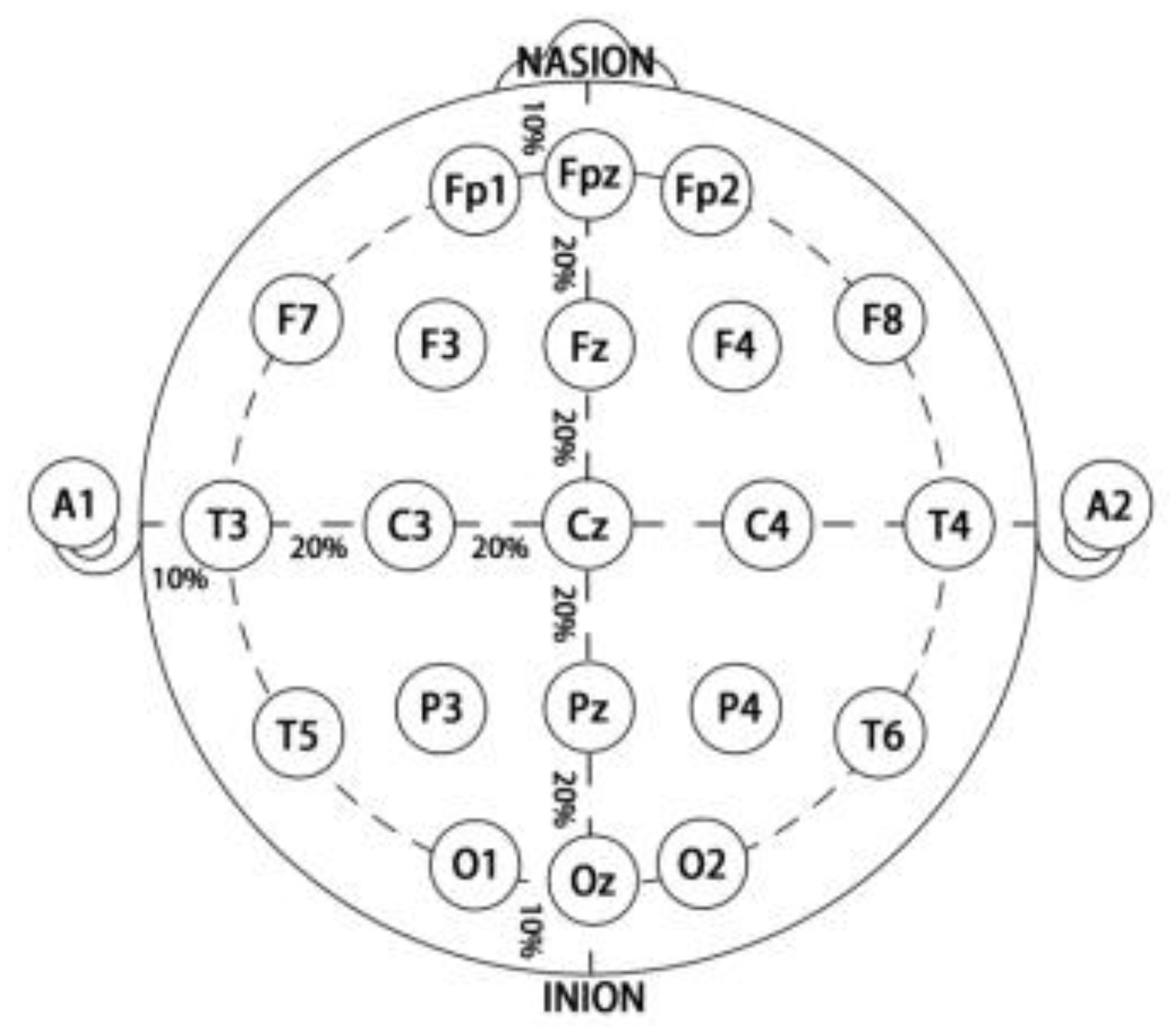
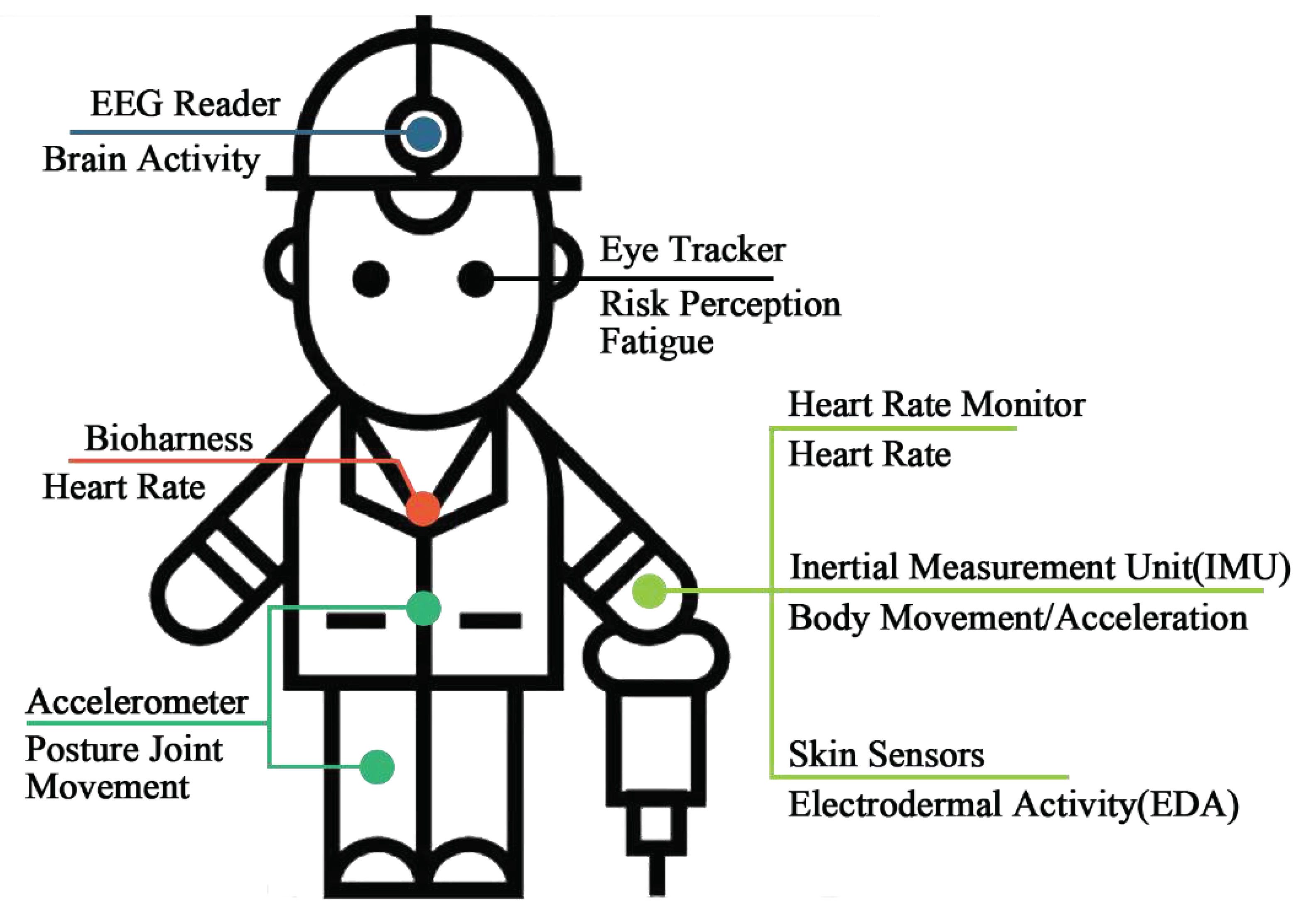
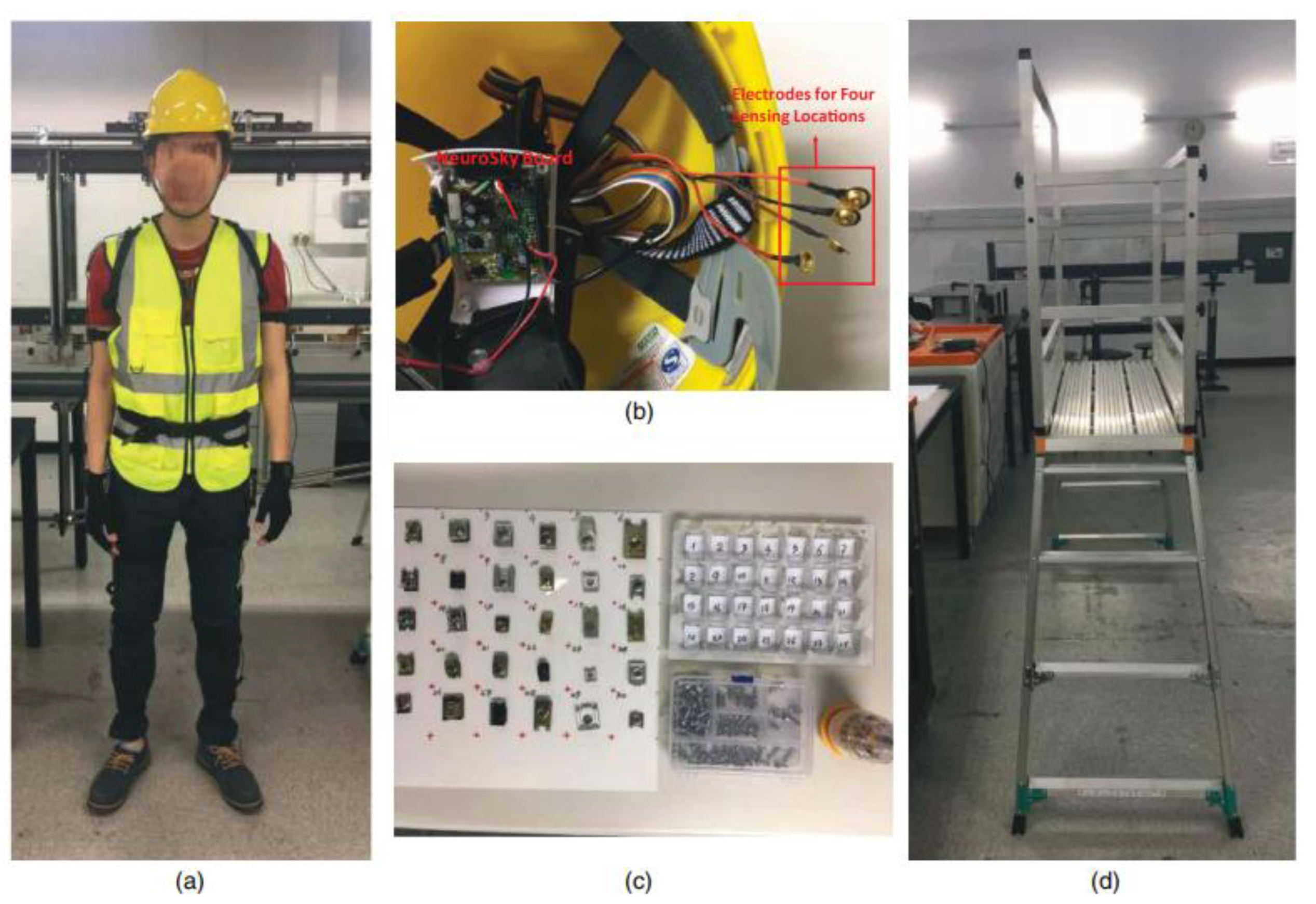
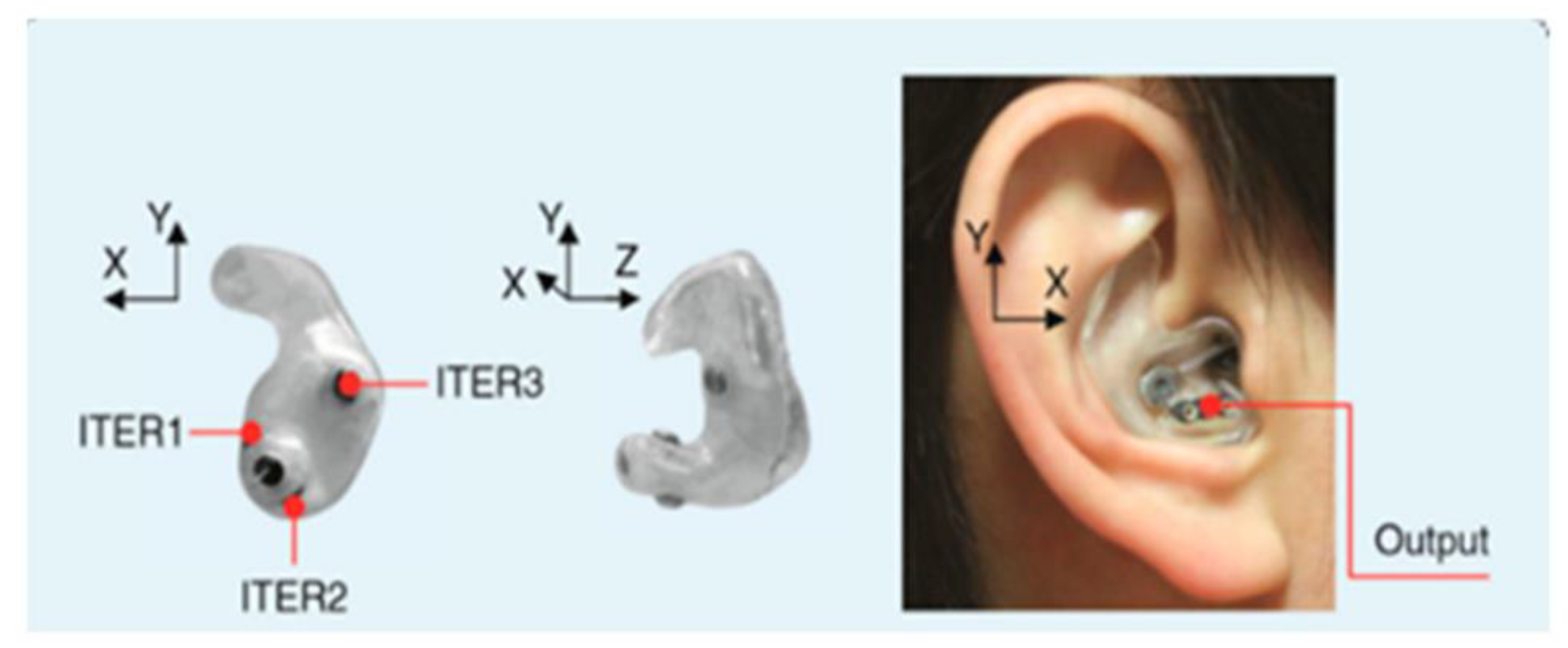
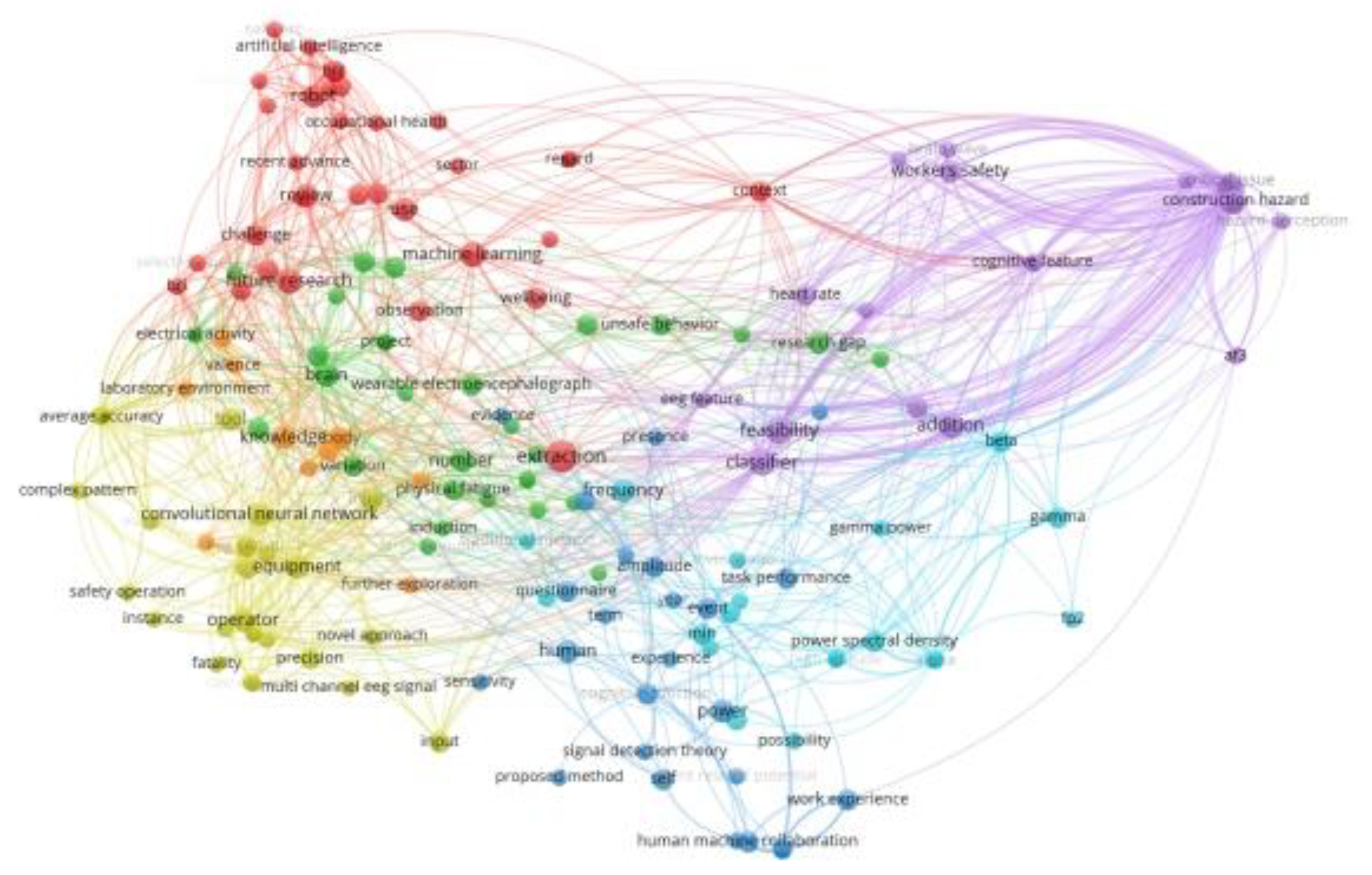
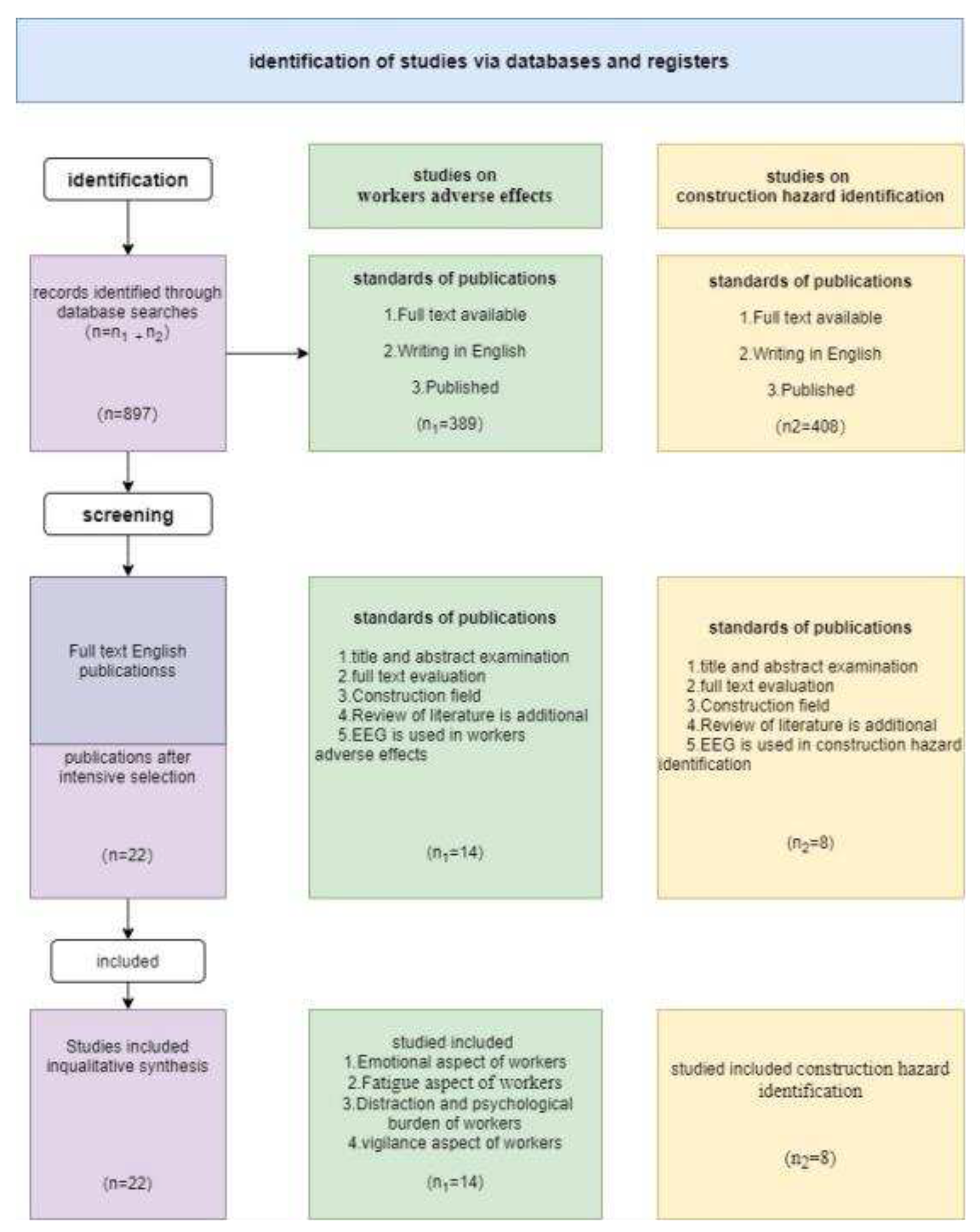
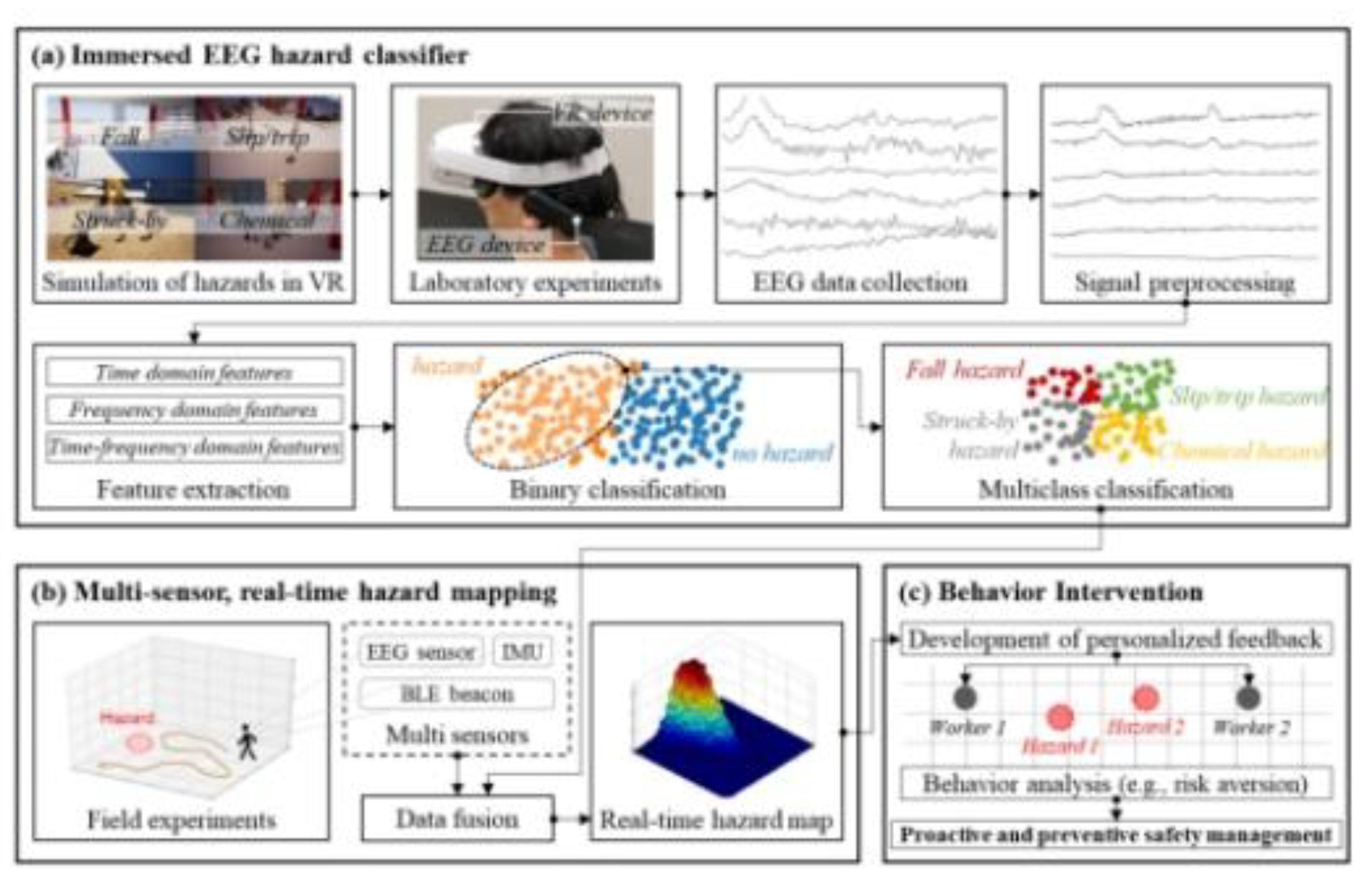
| Band name | Frequency band (Hz) | Subjective feeling state | Relevant mandates and behaviours |
| Delta (δ) | 0.5Hz-4Hz | dreamless sleep, non-REM sleep, asleep | Drowsiness, immobility, difficulty concentrating |
| Theta (θ) | 4Hz-8Hz | Intuition, recollection, deeply relaxed | Be creative and intuitive; Distraction, lack of concentration |
| Alpha (α) | 8Hz-13Hz | relaxed, not irritable, not sleepy | Meditative, no movement |
| Beta (β) | 13Hz-30Hz | Alert, excited, focused | Conduct mental activities |
| Gamma (γ) | 30Hz-Up | High performance | Advanced information processing and information-rich task processing |
| The time after being stimulated | Information exchange in different regions |
| 200 ms | The parietal lobe has a relatively active exchange of information with the whole brain. |
| 240-300 ms | There is relatively active information outflow from the lateral parietal region. |
| 200-500 ms | Strong information outflow was observed in the left temporal lobe region. |
| 400-600 ms | Strong information outflow was observed in the right parietal lobe region. |
Disclaimer/Publisher’s Note: The statements, opinions and data contained in all publications are solely those of the individual author(s) and contributor(s) and not of MDPI and/or the editor(s). MDPI and/or the editor(s) disclaim responsibility for any injury to people or property resulting from any ideas, methods, instructions or products referred to in the content. |
© 2023 by the authors. Licensee MDPI, Basel, Switzerland. This article is an open access article distributed under the terms and conditions of the Creative Commons Attribution (CC BY) license (http://creativecommons.org/licenses/by/4.0/).





